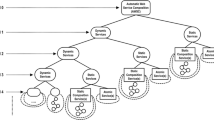Abstract
Automated service composition is an important approach to create aggregate services out of existing services. Several different approaches towards automated service composition exist. They differ not only in the used algorithms but also in provided functionality. While some support the creation of compositions with alternative or parallel control flow, others are missing this functionality. This diversity yields from a missing consensus on the required functionality to automatically compose real-world services. Hence, with this paper we aim at providing the foundation for such a consensus. We derived the required functionality from multiple business scenarios set up in the Adaptive Services Grid (ASG) project.
This paper presents results of the Adaptive Services Grid (ASG) project (contract number 004617, call identifier FP6-2003-IST-2) funded by the Sixth Framework Program of the European Commission.
Access this chapter
Tax calculation will be finalised at checkout
Purchases are for personal use only
Preview
Unable to display preview. Download preview PDF.
Similar content being viewed by others
References
Zeng, L., Benatallah, B., Lei, H., Ngu, A., Flaxer, D., Chang, H.: Flexible Composition of Enterprise Web Services. Electronic Markets – Web Services 13, 141–152 (2003)
Pistore, M., Barbon, F., Bertoli, P., Shaparau, D., Traverso, P.: Planning and monitoring web service composition. In: Workshop on Planning and Scheduling for Web and Grid Services (held in conjunction with The 14th International Conference on Automated Planning and Scheduling, pp. 70–71 (2004)
Sirin, E., Parsia, B., Wu, D., Hendler, J., Nau, D.: Htn planning for web service composition using shop2. Journal of Web Semantics 1, 377–396 (2004)
Berardi, D., Calvanese, D., Giacomo, G.D., Lenzerini, M., Mecella, M.: Automatic composition of e-services that export their behavior. In: Orlowska, M.E., Weerawarana, S., Papazoglou, M.P., Yang, J. (eds.) ICSOC 2003. LNCS, vol. 2910, pp. 43–58. Springer, Heidelberg (2003)
Berardi, D., Calvanese, D., Giacomo, G.D., Mecella, M.: Composition of services with nondeterministic observable behaviour. In: Benatallah, B., Casati, F., Traverso, P. (eds.) ICSOC 2005. LNCS, vol. 3826, pp. 520–526. Springer, Heidelberg (2005)
Curtis, B., Keller, M.I., Over, J.: Process modeling. Communications of the ACM 35, 75–90 (1992)
Jablonski, S., Böhm, M., Schulze, W. (eds.): Workflow Management – Entwicklung von Anwendungen und Systemen. dpunkt Verlag (1997)
Weske, M., Vossen, G.: Workflow Languages. International Handbooks on Information Systems. In: Handbook on Architectures of Information Systems, pp. 359–379. Springer, Heidelberg (1998)
Alonso, G., Casati, F., Kuno, H., Machiraju, V.: Web Services – Concepts, Architectures and Applications. Data-Centric Systems and Applications. Springer, Heidelberg (2004)
Nagarajan, M., Verma, K., Sheth, A.P., Miller, J.A., Lathem, J.: Semantic interoperability of web services – challenges abd experiences. In: Proceedings of the 4th IEEE Intl. Conference on Web Services (2006) (to appear)
Baader, F., Calvanese, D., McGuiness, D.L., Nardi, D., Patel-Schneider, P.F.: The Description Logic Handbook: Theory, Implementation, Applications. Cambridge University Press, Cambridge (2003)
Kifer, M., Lausen, G., Wu, J.: Logical foundations of object-oriented and frame-based languages. Journal of the Association for Computing Machinery 42, 741–843 (1995)
Erol, K., Nau, D.S., Subrahamnian, V.: Complexity, decidability and undecidability results for domain-independent planning: A detailed analysis. Technical Report CS-TR-2797, UMIACS-TR-91-154, SRC-TR-91-96, University of Maryland (1991)
Ghallab, M., Lau, D., Traverso, P.: Automated Planning - theory and practice. Morgan Kaufmann, San Francisco (2004)
van der Aalst, W., ter Hofstede, A., Kiepuszewski, B., Barros, A.: Workflow patterns. Distributed and Parallel Databases 14, 5–51 (2003)
Organization for the Advancement of Structured Information Standards (OASIS): Web Services Business Process Execution Language (WS-BPEL) (2004), http://www.oasis-open.org/committees/tc_home.php?wg_abbrev=wsbpel
Sacerdoti, E.: The nonlinear structure of plans. In: Proceedings of the International Joint Conference on Artificial Intelligence, pp. 206–214 (1975)
Erol, K., Handler, J., Nau, D.S.: Semantics for hierarchical task-network planning. Technical Report CS-TR-3239, UMIACS-TR-94-31, ISR-TR-95-9, University of Maryland (1994)
Nau, D., Au, T.C., Ilghami, O., Kuter, U., Murdock, W., Wu, D., Yaman, F.: Shop2: An htn planning system. Journal on Artificial Intelligence Research 20, 379–404 (2003)
Bäckström, C.: Computational aspects of reordering plans. Journal Of Artificial Intelligence 9, 99–137 (1998)
Leymann, F., Roller, D.: Production Workflow: Concepts and Techniques. Prentice-Hall, Englewood Cliffs (2000)
Sheth, A.P.: Changing focus on interoperability in information systems: From system, syntax, structure to semantics. In: Interoperating Geographic Information Systems, pp. 5–30. Kluwer Academic Publishers, Dordrecht (1998)
Kuropka, D.: Modelle zur Repräsentation natürlichsprachlicher Dokumente – Information-Filtering und -Retrieval mit relationalen Datenbanken. Logos Verlag, Berlin (2004)
Cardoso, J., Sheth, A.P., Miller, J.: Workflow quality of service. In: Proceedings of the International Conference on Enterprise Integration and Modeling Technology, pp. 303–311. Kluwer, B.V, The Netherlands (2002)
Cardoso, J., Sheth, A.: Semantic e-workflow composition. J. Intell. Inf. Syst. 21, 191–225 (2003)
Author information
Authors and Affiliations
Editor information
Editors and Affiliations
Rights and permissions
Copyright information
© 2006 Springer-Verlag Berlin Heidelberg
About this paper
Cite this paper
Meyer, H., Kuropka, D. (2006). Requirements for Automated Service Composition. In: Eder, J., Dustdar, S. (eds) Business Process Management Workshops. BPM 2006. Lecture Notes in Computer Science, vol 4103. Springer, Berlin, Heidelberg. https://doi.org/10.1007/11837862_42
Download citation
DOI: https://doi.org/10.1007/11837862_42
Publisher Name: Springer, Berlin, Heidelberg
Print ISBN: 978-3-540-38444-1
Online ISBN: 978-3-540-38445-8
eBook Packages: Computer ScienceComputer Science (R0)




